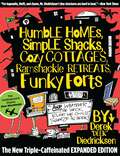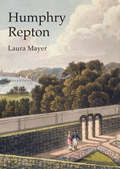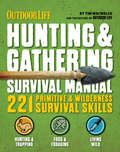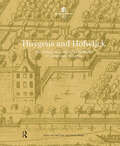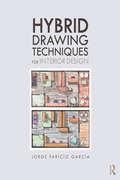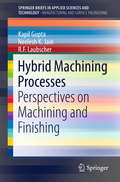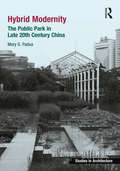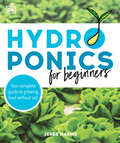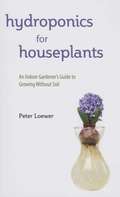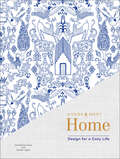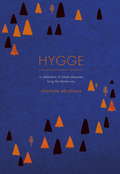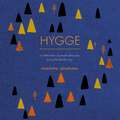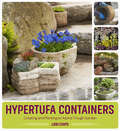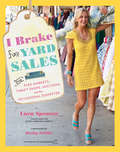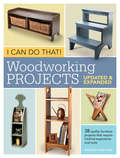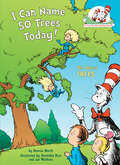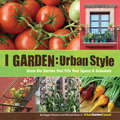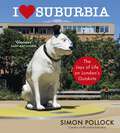- Table View
- List View
Humble Homes, Simple Shacks, Cozy Cottages, Ramshackle Retreats, Funky Forts: And Whatever the Heck Else We Could Squeeze in Here
by Derek DiedricksenThis Old House meets Wayne’s World in this zany guide to designing and building tiny homesDerek Diedricksen has always had a love for small, modest houses ever since his father gave him the book Tiny Tiny Houses by Lester Walker for his tenth birthday. Combining his artistic abilities, wild imagination, and his passion for small houses, he self-published Humble Homes, Simple Shacks, Cozy Cottages, Ramshackle Retreats, Funky Forts, and Whatever the Heck Else we could Squeeze in Here in 2009. This book is a collection of Diedricksen’s creative/imaginative sketches for building small houses, shacks, cottages, and forts. The sketches are accompanied with hand-written commentary, both instructive and comical. Derek’s main purpose is to get your creative juices flowing and encourage you to get off the couch and use your hands. Believing that specific building plans squash creativity, he avoids too many detailed instructions, giving you the chance to put your own creative spin on your very own small abode (even if it is just in your imagination).
Humphry Repton
by Laura MayerHumphry Repton (1752-1818) ambitiously styled himself Capability Brown's successor; the century's next great improver of landed property. He believed that the art of laying out grounds could only be achieved by 'the united powers of the landscape painter and the practical gardener', and ingeniously combined his knowledge of farming with a talent for topographical sketching. Over thirty years Repton amassed an incredible four hundred commissions, capitalizing on the whims of the fashion-conscious upper classes left rudderless after Brown's death. Sensitive and snobbish, Repton's ambitions were twofold. He sought to ingratiate himself among the aristocracy, whilst simultaneously raising the status of his adopted profession. Consequently his famous Red Books, illustrated to help clients visualize the potential of their estates, also encouraged an appreciation of landscape aesthetics. This book looks at Repton's theoretic principles and how they underpin his landscape gardening. By detailed site investigations, it traces his approach to landscape design from Picturesque wildernesses like Blaise Castle, Bristol, to the progressive Gardenesque style of Wanstead House in Greater London.
Hunt Club Management Guide: Building, Organizing, and Maintaining Your Clubhouse or Lodge
by J. Wayne FearsIf you ever wanted to create your own hunting club, this book is for you.In Hunt Club Management Guide, wildlife management consultant J. Wayne Fears teaches you how to take your dreams of owning and operating your own hunt club and make them reality. From locating the acres you'll build on to hanging your final set of antlers on the wall, Fears touches on everything you will need to start your own club.In addition to revealing the step-by-step process of organizing and building a great club, Fears also provides insight into maintaining a successful club that will last for decades. This insight includes tips to help:Generate a top-notch wildlife management programPlant and manage food plotsCreate effective rulesDraft contracts and agreementsDevelop quality deer management techniquesAttract deer to your landFrom club by-laws to game management plans, clubhouse to land acquisition, the Hunt Club Management Guide will be your manual for establishing an enjoyable and thriving hunt club.
Hunting & Gathering Survival Manual: 221 Primitive & Wilderness Survival Skills (Outdoor Life)
by Tim MacWelch The Editors of Outdoor LifeThis comprehensive guide is full of the strategies, skills, and gear you need to survive any catastrophe—from natural disasters to the collapse of society. All over America, families are transforming spare rooms into long-term storage pantries, planting survival gardens, unplugging from the grid, converting their homes to alternative sources of energy, taking self-defense courses, and stocking up on everything from canned food to ammunition. So what are these people preparing for? In our increasingly unstable world, there are a whole host of catastrophic event that could throw civilization into turmoil. Outdoor Life: Prepare for Anything takes you through these potential threats and explains how to be prepared for them. From having the right equipment to considering your actions in the wake of a disaster, or acquiring the skills needed for self-sufficiency, this guide is full of hands-on hints, easy-to-use checklists, and engaging first-person stories. This volume includes vital information on:• Necessary skills in a time of a natural disaster, economic collapse, or societal restructuring.• What should be in your house, pantry, basement, bunker, and go-bag. • How to handle yourself and your family in the wake of disaster, from creating a plan to leading your neighborhood watch.
Huygens and Hofwijck: The Inventive World of Constantijn and Christiaan Huygens
by Kees Leer Henk BoersConstantijn Huygens was a poet, composer and connoisseur of art and the classics. He was also secretary and confidant to three princes of Orange for 62 years. Hofwijck was also the place where Constantijn’s son Christiaan spent a significant part of his life. Christiaan Huygens was a member of the Royal Society of London for the Improvement of Natural Knowledge and became one of the greatest inventors and scientists. At the end of his life, at Hofwijck, he wrote Cosmotheoros, his magnum opus on the universe. At Huygens’s Hofwijck we look at the seventeenth century through the eyes of these two versatile men. With Constantijn and Christiaan, the story is about literature, art, music, politics, the House of Orange, science and life at a seventeenth-century country estate.
Hybrid Drawing Techniques for Interior Design
by Jorge Paricio GarciaHybrid Drawing Techniques for Interior Design shows you a flexible and productive design workflow that starts with hand drawing and moves on to digital techniques. In this book, digital and freehand images are displayed side-by-side, so that you can choose at every step which method is best for your desired effect. You will also learn how to draw freehand using a digital tablet, and how to render perspective views, elevations and floor plans. This book includes more than 400 color images and practice exercises that can be referenced online.
Hybrid Machining Processes
by Kapil Gupta Neelesh K. Jain R. F. LaubscherThis book describes various hybrid machining and finishing processes. It gives a critical review of the past work based on them as well as the current trends and research directions. For each hybrid machining process presented, the authors list the method of material removal, machining system, process variables and applications. This book provides a deep understanding of the need, application and mechanism of hybrid machining processes.
Hybrid Modernity: The Public Park in Late 20th Century China (Ashgate Studies in Architecture)
by Mary G. PaduaThis book provides a detailed historical and design analysis of the development of parks and modern landscape architecture in late 20th century China. It questions whether the fusion of international influences with the local Chinese design vocabulary in late 20th century China has created a distinctive and novel approach to the design of public parks. Hybrid Modernity proposes a new theory for examining the design of public parks built in post-Mao China since the reforms and sets the various processes for China’s late 20th century socio-cultural context. Drawing on modernization theory, research on China’s modernity, local and global cultural trends, it illustrates through a range of case studies ways hybrid modernity defines a new design genre and language for the spatial forms of parks that emerged in China’s secondary cities. Featured case studies include the Living Water Park in Chengdu, Sichuan province, Zhongshan Shipyard Park in Guangdong Province, Jinji Lake Landscape Master Plan in Suzhou, Jiangsu province, and the West Lake Southern Scenic Area Master Plan in Hangzhou, Zhejiang province. This book argues that these forms represent a new stage in China’s history of landscape architecture. The work reveals that as a new profession, landscape architecture has greatly contributed to China’s massive urban experiment. This book is an ideal read for students enrolled in landscape architecture, architecture, fine arts and urban planning programs who are engaged in learning the arts and international design education.
Hydroponic Tomatoes (Into Reading, Level Q #10)
by Heather Hammonds Sharyn MadderNIMAC-sourced textbook. Hydroponic tomatoes are different! They are grown in greenhouses, where they are protected from wildlife and wind. But how do hydroponic tomatoes taste?
Hydroponics for Beginners: Your Complete Guide to Growing Food Without Soil
by Jeree HarmsYou don&’t need the sun or soil to grow food. Wouldn&’t it be great if you could plant and grow food in your house year-round? No more needing to be out in the summer sun. No more needing to find the right soil combination. No more needing to wait until spring or autumn to begin planting. With hydroponics, you can grow food inside your house without having any sun or any soil. Hydroponics for Beginners has all the information you need to set up your own inside garden, including the benefits of hydroponics, the equipment required, and the best system to use. This book also includes these features:Step-by-step techniques for building your hydroponic systemExpert guidance on how to start your seeds and how to light your systemPlanting recommendations for the best kinds of foods to grow hydroponicallyNutrient guides to help your plants burst and thriveTroubleshooting tips to help maintain your hydroponic system Hydroponics for Beginners will explain everything you need to know to not only build a hydroponic system in your home but to also ensure you&’re successful with whatever you grow. Also, if you&’re ever stuck on the Moon or on Mars, if you can find a little water and happen to have some nutrient-rich solutions, you can grow food and survive until someone rescues you. Just make sure you also have a copy of Hydroponics for Beginners with you!
Hydroponics for Houseplants: An Indoor Gardener's Guide to Growing Without Soil
by Peter LoewerPick your container, fill it with water, and sit back and watch your plant grow!This book is the answer to anyone who has ever shied away from growing house plants because of messy dirt or fear of things dying if left for a few days without water. Ditch the hassle and learn how to grow plants indoors with nothing but water.Peter Loewer, an inveterate inventor of water gardening techniques, has written and illustrated this charming guide to teach readers the basics of hydroculture. This technique of growing plants in water has a history of almost 300 years, from experiments by an English botanist to the giant automated factory greenhouses of the twentieth century where vegetables are now grown commercially by the ton. Learn how to utilize this simple, time-tested method in your own home and never worry about over- or under-watering again!Peter Loewer, an inveterate inventor of water gardening techniques, has written and illustrated this charming guide to teach readers the basics of hydroculture. This technique of growing plants in water has a history of almost 300 years, from experiments by an English botanist to the giant automated factory greenhouses of the twentieth century where vegetables are now grown commercially by the ton. Learn how to utilize this simple, time-tested method in your own home and never worry about over- or under-watering again!
Hygge & West Home: Design for a Cozy Life
by Aimee Lagos Christiana CoopFrom the cofounders of the popular design company. “Inside the must-read, the duo takes us inside 20 homes that embody the hygge way of life.” —Architectural DigestTastemakers Christiana and Aimee of Hygge & West know that the key to making a house into a home is in the decoration—whether that means embracing natural elements, creating cozy spaces, making room for family, or finding your own personal charm in every space. Hygge & West Home offers a look into twenty covetable homes designed to promote feelings of coziness, companionship, and comfort, from an intimate apartment in San Francisco to a log cabin in Wyoming, a family home in Minneapolis, and a colorful oasis in Brooklyn. With page after page of aspirational interiors, engaging interviews with home owners, and tips on creating similar feelings in any space, this eye-catching book explores what makes a house a truly personal space and offers readers the tools and inspiration to make their home their own.“Christiana Coop and Aimee Lagos, creators of Hygge & West designs, know how to make the home a retreat, a soft and charming space that really embraces hygge, the Danish design term for a cozy, sweet environment.” —Unique Homes“A must-have resource if you are interested in design and interiors.” —Coral & Tusk
Hygge: A Celebration of Simple Pleasures. Living the Danish Way.
by Charlotte AbrahamsCandlelight is hygge; the smell of freshly brewed coffee is hygge; the feel of crisp, clean bed linen is hygge; dinner with friends is hygge. 'Hygge', pronounced 'hoo-ga', is a Danish philosophy that roughly translates to 'cosiness'. But it is so much more than that. It's a way of life that encourages us to be kinder to ourselves, to take pleasure in the modest, the mundane and the familiar. It is a celebration of the everyday, of sensual experiences rather then things. It's an entire attitude to life that results in Denmark regularly being voted one of the happiest countries in the world. So, with two divorces behind her and her 50th birthday rapidly approaching, journalist Charlotte Abrahams ponders whether it's hygge that's been missing from her life. Is it a philosophy we can all embrace? In a society where lifestyle trends tend to centre on deprivation - be it no sugar, no gluten, no possessions - what does cherishing yourself actually mean? And will it make her happy? In Hygge, Charlotte Abrahams weaves the history of hygge and its role in Danish culture with her own attempts, as an English woman, to embrace a more hygge life. In this beautifully written and stylishly designed book, she examines the impact this has on her home, her health, her relationships and, of course, her happiness. Light a candle, pour yourself a glass of wine, and get ready to enjoy your more hygge life.
Hygge: A Celebration of Simple Pleasures. Living the Danish Way.
by Charlotte AbrahamsCandlelight is hygge; the smell of freshly brewed coffee is hygge; the feel of crisp, clean bed linen is hygge; dinner with friends is hygge. 'Hygge', pronounced 'hoo-ga', is a Danish philosophy that roughly translates to 'cosiness'. But it is so much more than that. It's a way of life that encourages us to be kinder to ourselves, to take pleasure in the modest, the mundane and the familiar. It is a celebration of the everyday, of sensual experiences rather then things. It's an entire attitude to life that results in Denmark regularly being voted one of the happiest countries in the world. So, with two divorces behind her and her 50th birthday rapidly approaching, journalist Charlotte Abrahams ponders whether it's hygge that's been missing from her life. Is it a philosophy we can all embrace? In a society where lifestyle trends tend to centre on deprivation - be it no sugar, no gluten, no possessions - what does cherishing yourself actually mean? And will it make her happy? In Hygge, Charlotte Abrahams weaves the history of hygge and its role in Danish culture with her own attempts, as an English woman, to embrace a more hygge life. In this beautifully written and stylishly designed book, she examines the impact this has on her home, her health, her relationships and, of course, her happiness. Light a candle, pour yourself a glass of wine, and get ready to enjoy your more hygge life.
Hygge: A Celebration of Simple Pleasures. Living the Danish Way.
by Charlotte AbrahamsCandlelight is hygge; the smell of freshly brewed coffee is hygge; the feel of crisp, clean bed linen is hygge; dinner with friends is hygge. 'Hygge', pronounced 'hoo-ga', is a Danish philosophy that roughly translates to 'cosiness'. But it is so much more than that. It's a way of life that encourages us to be kinder to ourselves, to take pleasure in the modest, the mundane and the familiar. It is a celebration of the everyday, of sensual experiences rather then things. It's an entire attitude to life that results in Denmark regularly being voted one of the happiest countries in the world. So, with two divorces behind her and her 50th birthday rapidly approaching, journalist Charlotte Abrahams ponders whether it's hygge that's been missing from her life. Is it a philosophy we can all embrace? In a society where lifestyle trends tend to centre on deprivation - be it no sugar, no gluten, no possessions - what does cherishing yourself actually mean? And will it make her happy? In Hygge, Charlotte Abrahams weaves the history of hygge and its role in Danish culture with her own attempts, as an English woman, to embrace a more hygge life. In this beautifully written and stylishly designed book, she examines the impact this has on her home, her health, her relationships and, of course, her happiness. Light a candle, pour yourself a glass of wine, and get ready to enjoy your more hygge life.Written and read by Charlotte Abrahams(p) 2016 Orion Publishing Group
Hypertufa Containers: Creating and Planting an Alpine Trough Garden
by Lori ChipsHypertufa containers—also known as troughs—are rustic, striking, versatile, and perfect for small, Alpine plants. A mix of cement, perlite, peat, and water, they are simple and affordable to make at home. Hypertufa Containers details everything you need to know to make your own troughs and successfully garden in them. From plant portraits that include growing and cultivation information along with potting tips you’ll discover the amazing variety of plants that thrive in troughs. Hypertufa Containers features step-by-step instructions and color photography for making hypertufa containers in a variety of shapes and sizes.
Hühner im eigenen Garten: Der komplette Leitfaden vom Küken bis zur Legehenne
by Isaac MillerHühner im eigenen Garten zu halten, ist viel einfacher als so manch anderes Haustier. Ein paar Minuten Kontrolle am Tag reichen, um täglich frische Eier genießen zu können. In disem Buch werden wir die nötigen Schritte durchgehen, von Kauf und Pflege der jungen Küken bis zur Umsiedlung in den Stall im Garten, mit allem, was dazwischen geschieht. Nehmen Sie sich etwas zu trinken und einen Snack, finden Sie einen schönen Platz zum schmökern und gemeinsam entdecken wir, welche Freude Hühner im Garten bereiten können. In diesem Buch werden wir Sie begleiten bei: Platzsuche und Stallgröße Auswahl einer Hühnerrasse Aufzucht der Küken Umsiedeln in den Stall Stallund Auslauf sauber halten Hühner richtig füttern Genießen Sie das Leben mit diesem Buch und Ihren gefiederten Freunden!
I Brake for Yard Sales: And Flea Markets, Thrift Shops, Auctions, and the Occasional Dumpster
by Lara SpencerThe New York Times bestseller by the host of HGTV’s Flea Market Flip, packed with expert tips for bargain-hunting home decorators.Former Good Morning America and Antiques Roadshow host Lara Spencer is a self-confessed frugalista with a passion for shopping at yard sales, thrift shops, and estate sales, and for decorating her home—and friends’ homes—with her fabulous finds. In I Brake for Yard Sales, Lara shares her secrets for bargain hunting and tells you where to shop, what to look for, how to pay for it, how to restore it, and finally, where to put it in your house. Peppered with wisdom from world-renowned appraisers as well as contributions from well-known designers, this book also features the house of comedienne and good friend Kathy Griffin, which Spencer herself refurbished and decorated.
I Can Do That! Woodworking Projects: 17 Quality Furniture Projects That Require Minimal Tools And Experience (I Can Do That! Ser.)
by David ThielYou can do that, quickly, easily and save money! Beginning woodworkers (or experienced woodworkers that are in a hurry) can build these top-quality projects quickly and efficiently. Each project requires a minimum of tools (only hand and portable power tools) and a minimum of woodworking experience. These projects need only inexpensive materials that are easily found at your local home center stores, saving you time and money. This book includes a training manual for using each tool, making it perfect for the beginning woodworker. The projects are not the typical napkin holders. They are tasteful and useful, making this book a good choice for the experienced woodworker in a hurry!
I Can Name 50 Trees Today! All About Trees: All About Trees (The Cat in the Hat's Learning Library)
by Bonnie WorthLaugh and learn with fun facts about trees like the redwood, white oak, royal palm, and more—all told in Dr. Seuss&’s beloved rhyming style and starring the Cat in the Hat! &“Knowing trees&’ names, my dear miss and dear mister, is like knowing the name of your brother or sister." The Cat in the Hat&’s Learning Library series combines beloved characters, engaging rhymes, and Seussian illustrations to introduce children to non-fiction topics from the real world! Branch out and learn about: the different parts of a treehow to identify different specieswhy a tree has barkand much more! Perfect for story time and for the youngest readers, I Can Name 50 Trees Today! All About Trees also includes an index, glossary, and suggestions for further learning. Look for more books in the Cat in the Hat&’s Learning Library series!High? Low? Where Did It Go? All About Animal CamouflageIs a Camel a Mammal? All About MammalsThe 100 Hats of the Cat in the Hat: A Celebration of the 100th Day of SchoolA Great Day for Pup: All About Wild BabiesWould You Rather Be a Pollywog? All About Pond LifeHappy Pi Day to You! All About Measuring CirclesFine Feathered Friends: All About BirdsMy, Oh My--A Butterfly! All About ButterfliesOh Say Can You Seed? All About Flowering PlantsInside Your Outside! All About the Human BodyIce is Nice! All About the North and South Poles
I Garden - Urban Style: Grow The Garden That Fits Your Space And Schedule
by Reggie Solomon Michael NolanA Garden for Your Space & Your StyleYou can grow delicious, healthy vegetables and beautiful flowers in your urban setting. No yard? No problem, you have more options available than you think ™from containers and window boxes to raised beds and community plots. No time? No worries, there are plants and containers that accommodate even the busiest schedule. Inside you'll find: Ideas for growing plants in any available space--no matter how small or soil deficient Step-by-step instructions on growing plants from seed Suggestions for plants and containers that fit various styles and schedules, including: no-fuss hardy producers; stunning plantscapes; and plants that attract birds and butterflies Advice on composting, pest control, watering and fertilizing Strategies for maintaining your garden while you are away More than 20 recipes featuring fresh ingredients you can grow Resources to help you build a gardening community in your neighborhood or on the InternetReggie Solomon and Michael Nolan of the popular website UrbanGardenCasual.com show you everything you need to know to grow a garden that fits your tight urban space and busy schedule. Shed your work clothes, grab your iPod and start enjoying your urban garden today.The Urban Garden Casual Philosophy is about reclaiming the peace, relaxation and satisfaction that comes from growing something yourself.
I Have Nothing to Wear!: A Painless 12-Step Program to Declutter Your Life So You Never Have to Say This Again!
by Jill Martin Dana RavichYou know the feeling: the anxiety, the dread, and the utter certainty that in spite of all of the options in the overcrowded closet before you, you have nothing to wear. The advent of discount retailers that offer up-to-the-minute fashion trends has only deepened the problem. Though our dresser drawers are overflowing with options, the daily crisis remains the same. Help has arrived! In I Have Nothing to Wear! fashion expert Jill Martin and fashion stylist Dana Ravich have teamed up to create a fun and practical 12-step program that promises to help even the most seemingly hopeless cases. Learn how to edit your wardrobe, figure out the fashion basics, get organized, steer clear of flash-in-the-pan trends, and pinpoint and project a personal style all your own.And have fun along the way!Jill and Dana will steer you through the steps, which include admitting your closet is a mess, determining how clothes fit in with your lifestyle, and finding friends who will tell you the truth about what needs to stay or go! I Have Nothing to Wear! is the perfect guide to help you make your way through the minefield of modern fashion and choose the perfect ensembles for work, play, and love.
I Love Suburbia: The Joys of Life on London’s Outskirts
by Simon Pollock'Brilliant. London never looked so good. A glorious celebration of the city that will leave a big smile on your face.’ Daisy May Cooper'This book celebrates suburbia in all its quirky glory' Daily MailSEE LONDON IN A NEW LIGHT THROUGH STORIES AND PHOTOS OF OVER 100 HIDDEN SPOTS IN THE SUBURBSHow many of us have marvelled at the unexpected beauty of an art deco cinema, had our heads turned by the magnificent Hoover Factory on the A40, or wondered at a mosaic-covered house in Chiswick?From stations that wouldn't be out of place in Miami Beach to cinemas converted to megachurches, I Love Suburbia brings to life the joys of living outside Zone 1. Step back in time and revisit simpler days in the suburbs to discover the pioneering interwar architects who brought modernism to Britain, or delight in the elegance of Art Deco buildings given a new lease of life. Filled with stories of the people who live, work and play in the outskirts of London, this full-colour book is an exploration of the capital’s overlooked everyday treasures.Brought together by Simon Pollock, the creator of Instagram’s heartwarming @LondonSuburbia, with over 200 original photos of unusual charm from Chingford to Leatherhead, Beaconsfield to Becontree, this is the suburbs as you've never seen them before.
I Modify IKEA: Furnishings from Everyone's Favorite Store, Customized for Your Home
by Charlotte Rivers Elyse MajorCUSTOMIZE YOUR FAVORITE IKEA® HOME FURNISHINGS WITH DIY PROJECTS You love IKEA® for its affordable, high-quality home furnishings. Now thanks to this book&’s DIY decorating projects, you can easily transform those furnishings into fully customized decor. Packed with 200 step-by-step illustrations and instructions, I Modify IKEA® offers a range of inspiring ideas to reflect your unique style. Living room: appliqué pillows Dining room: a rolling bar cart Kitchen: embroidered dish towels Bedroom: decorated nightstands Closet: an adorable jewelry box Bathroom: unique shelving Kid's room: a box set dollhouse Office: a cozy reading bench.
I See Joy (Life Through My Lens)
by Kaitlyn Duling Allen R. Wells Alma Patricia Ramirez Martin WongIf you look closely, joy is everywhere. Where do you see joy? Instill a joy for reading while learning about the feeling with the children’s book I See Joy!Joy feels and looks different for everybody. This kid’s book illuminates the real lives of four different people and gives readers a close-up look at how people experience and describe one of life’s most beautiful feelings—joy.Fun Storybook Features:This children’s book includes a photo glossary and reading tips, questions, and activities.16 pages with vibrant photographsAbout RourkeWe proudly publish respectful and relevant non-fiction and fiction titles that represent our diverse readers, and are designed to support reading on a level that has no limits!
